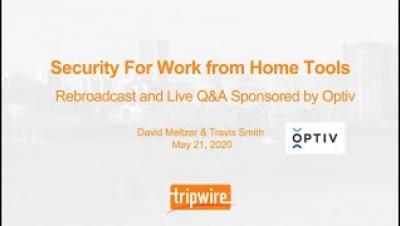Security | Threat Detection | Cyberattacks | DevSecOps | Compliance
Tripwire
NetWalker Ransomware - What You Need to Know
NetWalker (also known as Mailto) is the name given to a sophisticated family of Windows ransomware that has targeted corporate computer networks, encrypting the files it finds, and demanding that a cryptocurrency payment is made for the safe recovery of the encrypted data.
Security for Work from Home Tools with Live Q&A Sponsored by Optiv
The MITRE ATT&CK Framework: Exfiltration
Once an attacker has established access and pivoted around to the point of gathering the necessary data, they will work on exfiltration of that data. Not all malware will reach this stage. Ransomware, for example, usually has no interest in exfiltrating data. As with the Collection tactic, there’s little guidance on how to mitigate an attacker exfiltrating data from the enterprise.
Business Continuity Requires Infrastructure Continuity in Times of Remote Working
Over the last few weeks, most organisations have had to transition to enable their employees to work remotely. The key focus has been on business continuity during this trying time. Unfortunately, business continuity isn’t so easy. Keeping the day-to-day operations of the business running has been one of the hardest IT challenges that most organisations have faced in the last decade. It’s one for which many organisations might not have had a plan in place.
The Biggest Cybersecurity Issues in 2020
Protecting Fleet Data from Security Threats
Big data is revolutionizing fleet management — specifically in the form of telematics. From engine diagnostics that track fuel efficiency and mileage to sensors that detect aggressive driving behavior and interior vehicle activity, this information is so valuable that we’re quickly approaching the point where connected technology will come standard in every vehicle. Telematics is an operational goldmine.
How to Protect the Future of IT
Working remotely, either from home or from elsewhere, isn’t something new. It has been used by many companies worldwide over the past decade. That said, it was typically restricted to only a couple days a month or to specific IT-savvy departments. But as we have seen throughout time, adversity and crisis lead to change and sometimes revolutions in industry, social systems, countries and/or sometimes the entire world. COVID-19 has brought about this level of change.
Climbing the Vulnerability Management Mountain: Reaching the Summit (VM Maturity Level 5)
Only the truly committed ever reach the summit of anything. This sentiment holds true for vulnerability management. An organization cannot reach the summit without a serious commitment to fund and staff the program appropriately across the organization. Reaching ML:5 means tying the program to the business. Everyone must be aligned with the metrics and be ready to find the root cause of any misses so that mitigations can be implemented to alleviate this miss in the future.
Observing a Privacy Milestone: Expert Thoughts on GDPR's 2nd Anniversary
May 25, 2020 marks the second anniversary of when the European Union’s General Data Protection Regulation (GDPR) took full effect. Undoubtedly, many organizations have succeeded in achieving compliance with the Regulation by now. But that raises some important questions. What benefits have those organizations experienced in achieving compliance, for instance? Have they encountered any drawbacks along the way?





